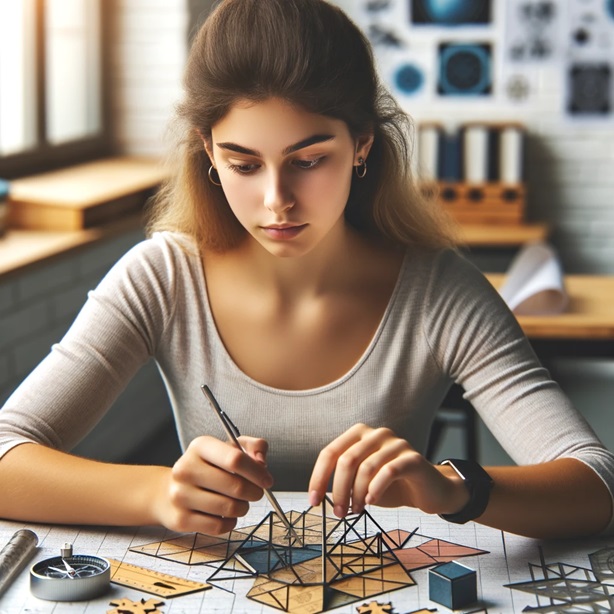Spatial Intelligence Training: Techniques and Applications

What is Spatial Intelligence?
Spatial intelligence, or visuospatial ability, is the capacity to understand, reason, and remember the spatial relations among objects or space. It's crucial for tasks that involve visualization of scenarios, manipulating environments, or understanding graphical data, making it fundamental in fields such as architecture, engineering, and navigation.
Spatial intelligence also plays a significant role in artistic endeavors, where visualizing and manipulating images or designs is essential. It is one of the multiple intelligences identified by psychologist Howard Gardner and is crucial for many cognitive tasks that require spatial awareness, depth perception, and mental rotation of objects.
Key Techniques to Enhance Spatial Intelligence
Enhancing spatial intelligence involves diverse techniques that cater to improving one’s ability to visualize and manipulate objects mentally. These include:
- Mental rotation exercises: Practicing the mental rotation of objects in 2D or 3D space can significantly enhance one's spatial visualization skills. These exercises can involve mental imagery of objects from different angles or manipulating virtual objects on a screen.
- Navigation tasks: Regularly engaging in navigation exercises, such as map reading or playing video games that require navigation, can improve spatial reasoning. These tasks enhance spatial awareness by requiring individuals to understand spatial relationships in complex environments.
- Geometric puzzle solving: Working with geometric shapes and solving puzzles like tangrams and Rubik’s Cube aids in developing better spatial analysis abilities. These puzzles require visualizing spatial relationships and manipulating shapes to fit a desired pattern or solution.
- Spatial visualization training: Engaging in activities that require visualizing spatial configurations, such as constructing models or designing layouts, enhances spatial intelligence. These activities involve planning and visualizing spatial arrangements, which strengthens spatial reasoning skills.
- Artistic endeavors: Engaging in artistic activities, such as drawing, painting, or sculpting, enhances spatial intelligence by developing skills related to visual perception, spatial relationships, and mental imagery. These activities encourage creative expression while improving spatial awareness and manipulation abilities.
Applications of Spatial Intelligence
Spatial intelligence is not just beneficial but essential in many professional and academic settings. Architects and engineers use it to envision and design structures. Pilots and sailors rely on spatial reasoning for navigation. Even in everyday life, effective spatial reasoning enhances problem-solving abilities and can improve performance in sports and driving.
In STEM fields, spatial intelligence is crucial for understanding and manipulating scientific and mathematical concepts. It enables individuals to visualize abstract ideas, understand complex systems, and solve technical problems. In artistic fields, spatial intelligence is key to creating and appreciating visual arts, as it involves understanding spatial relationships, proportions, and perspectives.
In sports, spatial intelligence plays a role in understanding and navigating the playing field, anticipating opponents' movements, and strategizing plays. In everyday tasks, such as navigating new places or arranging furniture, spatial intelligence helps individuals orient themselves, understand spatial relationships, and plan actions effectively.
Implementing Spatial Intelligence Training in Education
Integrating spatial intelligence training into educational curricula can foster students' cognitive development and prepare them for STEM (Science, Technology, Engineering, Mathematics) careers. Educational strategies could include interactive learning environments, spatially challenging games, and practical tasks that encourage visual and spatial analysis.
Spatial intelligence training in education can enhance students' problem-solving abilities, creativity, and spatial reasoning skills. Interactive learning environments, such as virtual reality simulations or hands-on experiments, engage students in spatial tasks and encourage exploration and discovery. Spatially challenging games, such as puzzle games or strategy games, develop spatial awareness and strategic thinking.
Practical tasks, such as building models or designing layouts, provide opportunities for spatial visualization and manipulation. These tasks encourage students to think critically, plan spatial arrangements, and solve complex spatial problems, which are valuable skills in many academic and professional settings.
Conclusion
Developing spatial intelligence through targeted training exercises can lead to significant improvements in both personal and professional capacities. As we understand more about the brain's ability to adapt and change, spatial intelligence training stands out as a valuable tool for cognitive enhancement and practical skill development across various fields.
By enhancing spatial intelligence, individuals can improve their ability to understand and interact with the spatial world, leading to greater success in diverse domains. Whether for professional development, academic achievement, or personal growth, spatial intelligence training offers valuable benefits and opportunities for cognitive and practical enhancement.